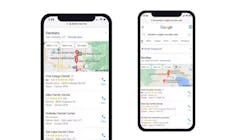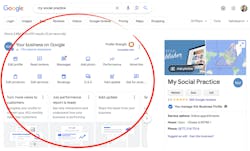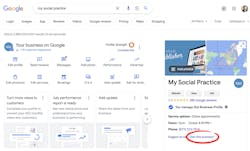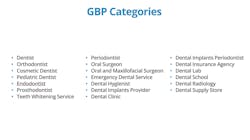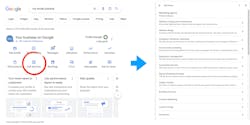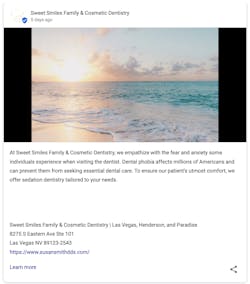Your Google Business Profile (GBP) is your listing on the Google Map. The information does not come from your website. Most practice owners are not aware that they can use dental SEO strategies to optimize their listing and help it rank higher. Ultimately, that listing will increase local awareness and improve practice growth.
Why is your GBP critical to new-patient flow?
Most new patients use Google Maps to find a nearby dentist. The top three GBP listings are on the first page of the search result. You'll get the lion's share of new-patient phone calls if you rank in the top three listings. But optimizing your GBP listing is more than just patients finding you; it's also about being chosen.
Patients who become aware of your practice through any other marketing method, such as billboards, paid ads, or mailers, will often check your GBP listing for more information before calling or scheduling. Whether you like it or not, your GBP listing weighs heavily on dental marketing effectiveness and it’s where SEO for dentists begins.
How to optimize your GBP
This dental SEO guide discusses how to optimize your GBP listing and how to optimize your website to improve your GBP rankings. Before spending a lot of time optimizing, you should see how well you already rank. You can do this by checking your current Google Maps rankings. How your practice ranks on Google Maps is location-based. This means your listing ranks higher or lower on the map based on where someone searches. The further away someone is from your practice when they search, the less likely your listing will rank high on the map.
The question becomes, "How far from my practice location are patients able to find my listing on the first page of the Google map?" One way to answer is to drive around doing searches from your phone and checking to see how high your listing shows up. But who has time to do that? Enter Google Heat Mapping!
The image below shows how a practice ranks for the keyword "dental implants near me" in their area. Each one of the colored dots is a search result. It's as if you were standing at that location, pulled out your phone, and searched "dental implants near me." The number on the colored dot is where the practice listing shows up on the map. The lower the number, the better. If the number is 1, 2, or 3, you're on the front page of the Google map.
Each keyword will create a different heat map. The image below is the same practice as above but for the keyword "dentist." Notice that the practice ranks slightly different than for dental implants. Request your practice heat maps
Now that you know how well you rank, you can optimize your listing for high-value patients and services.
1. Find, claim, and verify your listing
Go to Google and search the name of your practice. If you’re logged into a Google account that’s the owner or manager of your GBP, you'll see editing capabilities in the search results. Below is an image of the result when I searched for "My Social Practice." I was logged into a Google account that’s a manager on My Social Practice's GBP. Notice an editing panel at the top of the search results.
If you don’t see the editing section, you're not logged into the correct Google account, or your listing has not been claimed. To see if your listing has been claimed, all you need to do is click on the button circled in red in the image below. If your listing has been claimed, you'll see a partial email address for the email that is the owner of the listing. If not, you'll be prompted to claim the listing. If you have any problems, contact our Google maps optimization team.
2. Verify your NAP and categories
Once you have access to your listing, you'll want to ensure that your name, address, and phone (NAP) are correct. Google offers some instructions on how to name your listing. The primary category of your listing is essential for rankings. Choose your primary category from Google's predetermined list of dental categories. Here is a current list of all dental categories.
If you're a general dentist, your primary category should be "dentist." A common mistake is to use "dental clinic" as your primary category. I strongly recommend against this because very few patients search for the keyword "dental clinic." If you're a specialist, choose your specialty as your primary category.
You can also choose additional categories; our recommendation is to choose as few as possible, two to three at the most. Here's a good example; a general dentist who offers implants and also has an orthodontist on staff would choose “dentist” as the primary category, “dental implant provider” as the secondary category, and “orthodontist” as the third category.
3. Add dental services
Google allows you to list as many services as you’d like. Click on the edit services button and a pop up will appear where you can add or edit services. I suggest adding as many services as possible because Google will use the information in your services section for the search phrases. If someone searches for "Invisalign dentist near me" and you don't have Invisalign listed as a service, you may not show up. There is no limit to the number of services you can add, at least not a limit that we’ve found.
4. Add all 20 service areas
From the editing panel, click on Edit Profile < Location < Service Areas. In the service area panel, you can list up to 20 service areas. The best practice for this is to look at your Google Heat Maps and add service areas where it’s moving from green to yellow or orange, which is where you’re losing rankings. It doesn't make sense to put in high-density locations miles away from your practice if you're not ranking in the neighborhoods closest to your practice. The goal is to expand your reach on Google maps by sending signals that are on the edge of where you’re currently ranking.
5. Post a minimum of twice a month
GBPs allow for posts. It's like posting to a social media account. When you post, you're allowed to include a link. The best practice is to link to an offer on your website, new blog post, service page, or social media account. Below is an excellent example of a Google Business Profile post for Sweet Smiles Family & Cosmetic Dentistry that links to their sedation dentist service page. Links are the way that Google and other search engines connect information. Links from your GBP to your website and vice versa are a helpful way to connect the dots, make things easy for Google, and improve your link profile.
6. Acquire new Google reviews
Acquiring consistent Google reviews helps your listing rank. Even Google has stated that a business's review profile impacts prominence, a critical ranking factor. Most importantly, a great Google review profile will convince patients searching for a dentist to choose you instead of your competition. Digital marketing is all about being found and chosen. Acquiring more Google reviews is a chosen strategy.
The best practice for obtaining more Google reviews is to run a short-term Google review campaign with your team. Make it fun. Set a monthly goal to get 50 to 150 reviews or more and offer a great prize for reaching the goal. Don't be afraid to invest some money with the prize; it will pay off tenfold. Download this complimentary Google review campaign kit if you want some materials to kick off a campaign.
Once you've ended your short-term campaign, turn on automation. Automating your Google reviews will send a text link to patients after they've checked in, asking for a review. If you don’t have an automation, get it. Don't stress about sending the link to everyone and potentially getting a bad review. You'll get 95 great reviews to five poor ones. Frankly, if you're getting more negative reviews than that, you have a bigger problem than a few bad reviews. Embrace negative reviews as a way to improve your dental care.
How to improve Google map rankings with your website
Although the information on your GBP listing does not come from your website, Google uses the SEO strength of your website to support your Google listing in Maps. The better your website ranks, the better your listing will rank. Here are six essential ways to improve your website SEO and resources.
1. Fix technical website errors
Unless you have a super sharp web nerd on your team, this is where a dental marketing company can help. Technical errors involve things that mess with Google's crawlers and devalue a visitor's experience on your website. Technical issues include slow page load times, broken links, SSL and HTTPS, nonmobile optimized sites, bad Java script, incorrect metadata, and 404 pages.
To see how well you're doing with technical SEO, run a technical SEO analysis, which will give you a graded score. You want A grades on your analysis; above 90% is the goal. If they could be better, call your website design company and ask them to help you get a passing score.
2. You must have custom copywriting
Custom and original content stands as a cornerstone in digital dental marketing. The fundamental reason? Search engines, including Google, place a high premium on unique content. A search engine's primary objective is to deliver the most relevant information to consumers. When a dental practice updates its website with custom content, it signals to search engines that it is genuinely trying to provide unique value to its local patients. As a result, search engines interpret this as a reliable and authoritative information source worthy of a high ranking.
3. Blog more than your competitors
When you update your website with blot posts, search engines take notice. Fresh content signals that a website is active and invested in providing value. This elevates the site's ranking and positively impacts the rankings of its associated GBP. But how frequently should a dental practice blog? A helpful starting point is to analyze your competition. While the quality of content remains paramount, understanding the volume and length of competitor posts can guide practices in shaping their content strategy. For instance, if local competitors post 800 word articles biweekly, it’s a clear gauge for a practice to match or beat the amount and consistency.
4. Have an awesome internal link strategy
An internal link is on your website and it links to another part of your website. Google looks at links to understand what a dental practice is most interested in promoting. For instance, if you want to attract new dental implant patients, you must let Google know. You do this by creating a robust and custom dental implant service page with lots of internal links to the page.
A link from your home page to your dental implant service page is a must. In addition, you should regularly write blog articles about dental implants and link to the dental implant service page. When Google crawls your website, it will see that you are creating content focused on dental implants, and your rankings for that service will improve.
Pro tip: Use artificial intelligence to help you with blogging. Software such as ChatGPT can be extremely helpful in creating the first draft of your article, which will speed up your writing process. Always check for incorrect information because AI does not fact check. The algorithms are built on predictive models and patterns that often create "hallucinations," nonfactual information.
5. Have an even better inbound link strategy
An inbound link is one from another website to yours. A good example is a link from the ADA to your website. Some of the strongest inbound links that you can create are through guest blog posting. An example is writing a blog post about your relationship with the endodontist you refer cases to. You write the post and send it to your endodontist to be published on their website. Not only do you get a link back to your website, but the patients of the endodontist will be introduced to your dental office by the post.
The key is to get links from local, industry-relevant, and high-value websites. A link from the ADA or the AACD is a big deal because they’re some of the highest-value websites in the dental industry. But don't scoff at getting a link from a colleague's dental website, a local business, or a local media outlet. These are hyperlocal, relevant, and have a direct and significant impact on ranking on the Google map.
Pro tip: Post updates to your GBP and link to your service pages or blog posts. See the Sweet Smiles Cosmetic & Family Dentistry example above linking to their sedation dentist service page. This linking tactic makes it easier for Google to recognize what you specialize in and strengthens the bond between your Google map and website rankings.
6. SEO optimize your website images
Search engines primarily use text-based information to interpret and rank web content since they can't inherently understand images. Metadata, including alt text and image title, aids webmasters in conveying the significance of images to search engines, enhancing website ranking in search results.
Optimizing your images to help with dental SEO involves choosing the correct file format and compressing images so they load quickly. Each image should have a filename relevant to the page it's on. For example, the image on your "dental implant" service page should not be titled "IMG_837"; rather, it should be "dental implants in (your city)." Look at the file names of the images in this article about best dental website designs. To see the file name, right-click on them as if to download them. All the images have dental website design keywords.
Dental SEO guide conclusion
Dental SEO is no longer an optional dental marketing strategy—it's necessary. In a world where patients turn to Google Maps before scheduling, it’s paramount to ensure that your dental practice stands out. From understanding the nuances of you GBP to optimizing your website for higher map rankings, each step can significantly influence your online visibility and, consequently, your practice growth.
Remember, it's not just about being seen; it's about being chosen. Embrace these guidelines and employ the strategies mentioned and watch your dental practice soar to new heights on Google Maps.
About the Author
Adrian Lefler
Adrian is a dental marketing expert and the vice president of My Social Practice, a digital dental marketing agency. Lefler regularly travels to speak and educate dentists about dental marketing topics. You can book him to speak on this page. He lives in Draper, Utah, with his professional chef spouse, four kids, and two dogs.

